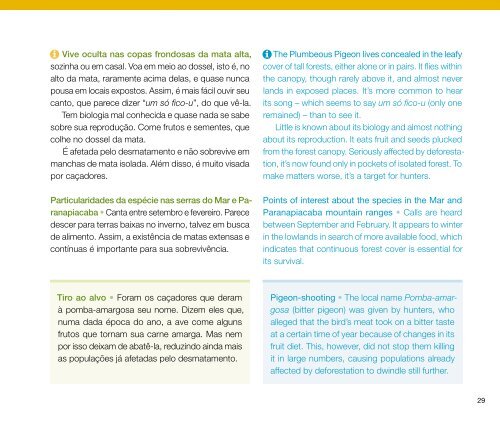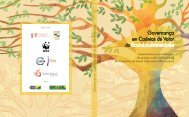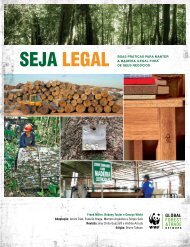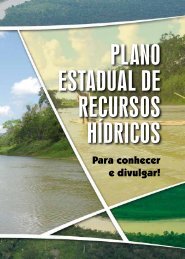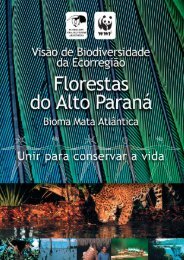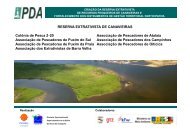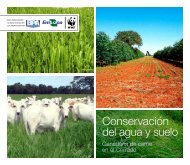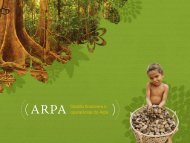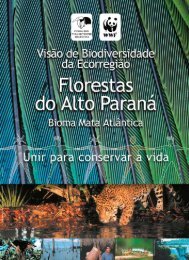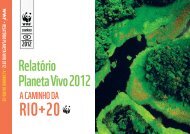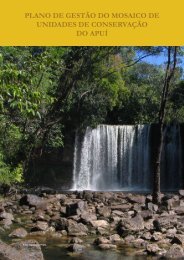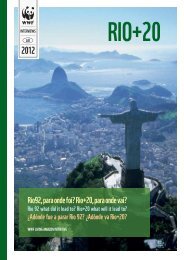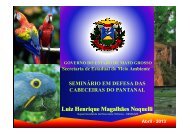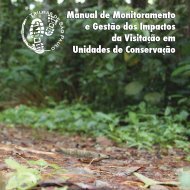Guia de aves Mata Atlântica Paulista
Guia de aves Mata Atlântica Paulista
Guia de aves Mata Atlântica Paulista
Create successful ePaper yourself
Turn your PDF publications into a flip-book with our unique Google optimized e-Paper software.
Vive oculta nas copas frondosas da mata alta,<br />
sozinha ou em casal. Voa em meio ao dossel, isto é, no<br />
alto da mata, raramente acima <strong>de</strong>las, e quase nunca<br />
pousa em locais expostos. Assim, é mais fácil ouvir seu<br />
canto, que parece dizer “um só fico-u”, do que vê-la.<br />
Tem biologia mal conhecida e quase nada se sabe<br />
sobre sua reprodução. Come frutos e sementes, que<br />
colhe no dossel da mata.<br />
É afetada pelo <strong>de</strong>smatamento e não sobrevive em<br />
manchas <strong>de</strong> mata isolada. Além disso, é muito visada<br />
por caçadores.<br />
Particularida<strong>de</strong>s da espécie nas serras do Mar e Paranapiacaba<br />
• Canta entre setembro e fevereiro. Parece<br />
<strong>de</strong>scer para terras baixas no inverno, talvez em busca<br />
<strong>de</strong> alimento. Assim, a existência <strong>de</strong> matas extensas e<br />
contínuas é importante para sua sobrevivência.<br />
The Plumbeous Pigeon lives concealed in the leafy<br />
cover of tall forests, either alone or in pairs. It flies within<br />
the canopy, though rarely above it, and almost never<br />
lands in exposed places. It’s more common to hear<br />
its song – which seems to say um só fico-u (only one<br />
remained) – than to see it.<br />
Little is known about its biology and almost nothing<br />
about its reproduction. It eats fruit and seeds plucked<br />
from the forest canopy. Seriously affected by <strong>de</strong>forestation,<br />
it’s now found only in pockets of isolated forest. To<br />
make matters worse, it’s a target for hunters.<br />
Points of interest about the species in the Mar and<br />
Pa ranapiacaba mountain ranges • Calls are heard<br />
between September and February. It appears to winter<br />
in the lowlands in search of more available food, which<br />
indicates that continuous forest cover is essential for<br />
its survival.<br />
Tiro ao alvo • Foram os caçadores que <strong>de</strong>ram<br />
à pomba-amargosa seu nome. Dizem eles que,<br />
numa dada época do ano, a ave come alguns<br />
frutos que tornam sua carne amarga. Mas nem<br />
por isso <strong>de</strong>ixam <strong>de</strong> abatê-la, reduzindo ainda mais<br />
as populações já afetadas pelo <strong>de</strong>smatamento.<br />
Pigeon-shooting • The local name Pomba-amargosa<br />
(bitter pigeon) was given by hunters, who<br />
alleged that the bird’s meat took on a bitter taste<br />
at a certain time of year because of changes in its<br />
fruit diet. This, however, did not stop them killing<br />
it in large numbers, causing populations already<br />
affected by <strong>de</strong>forestation to dwindle still further.<br />
29


